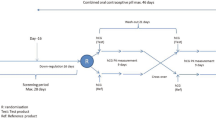Abstract
Purpose: Our purpose was to study the optimum time to administer exogenous human chorionic gonadotropin (hCG) to rescue the human corpus luteum during the luteal phase of normal menstrual cycles.
Methods: Groups of normally cycling women were given 4-day regimes of exogenous hCG by daily injection beginning 4 (Group A), 8 (Group B), and 12 (Group C) days after the midcycle luteinizing hormone surge. The hCG regime used was designed to mimic hCG levels following a spontaneous implantation. All subjects acted as their own controls in a preceding normal menstrual cycle.
Results: Group A subjects exhibited patterns and levels of salivary progesterone concentration similar to those seen in the control cycles throughout the normal luteal phase. In contrast, subjects in both Group B and Group C demonstrated a rapid and sustained increase in progesterone production following the hCG injections. Furthermore, subjects in Group B achieved the highest mean peak progesterone concentrations and the total amount of salivary progesterone secreted was significantly higher than in the control cycles (P < 0.05). Although the mean luteal-phase length was greatest in Group C, the response of the corpus luteum was suboptimal, with a delayed rise in salivary progesterone.
Conclusions: These data show that the qualitative and quantitative response of corpus luteum to an early pregnancytype hCG signal is maximal around the midluteal phase, coincident with the time of implantation.
Similar content being viewed by others
REFERENCES
Buvat J, Marcolin G, Guittard C, Herbaut JC, Dehaene JL, Verbecq P, Fourlinnie JC: A randomised trial of human chorionic gonadotrophin support following in vitro fertilisation and embryo transfer. Fertil Steril 1988;49:458-461
Quenby S, Farquharson RG: Human chorionic gonadotrophin supplementation in recurring pregnancy loss: A controlled trial. Fertil Steril 1994;62:708-710
Fritz LCMA, Hess DL, Patton PE: Influence of corpus luteum age on the steroidogenic response to exogenous human chronic gonadotrophin in normal cycling women. Am J Obstet Gynecol 1992;167:709-716
Wilks JW, Noble AS: Steroidogenic responsiveness of the monkey corpus luteum to exogenous chorionic gonadotrophin. Endocrinology 1982;112:1256-1266
Seif M W, Pearson J M, Ibrahim Z H, Buckley C H Aplin JD, Buck P, Matson P L Lieberman BA: Endometrium in in vitro fertilisation cycles: morphological and functional differentiation in the implantation phase. Hum Reprod 1992;7:6-11
Navot D, Scott T, Droesch K, Veeck LL, Liu HC, Rosenwaks Z: The window of embryo transfer and the efficiency of human conception in vitro. Fertil Steril 1991;55:114-118
Lenton EA, Gelsthorp CH, Harper R: Measurement of progesterone in saliva: Assessment of the normal fertile range using spontaneous conception cycles. Clin Endocrinol 1988;28:637-646
Lenton EA, Woodward AJ: The endocrinology of conception cycles and implantation in women. J. Reprod Fert Suppl 1988;36:1-15
Illingworth PJ, Reddi K, Smith K, Baird DT: Pharmacological “rescue” of the corpus luteum results in increased inhibin production. Clin Endocrinol 1990;33:323-332
Duncan WC, McNeilly AS, Fraser HM, Illingworth PJ: Luteinising hormone receptor in the human corpus luteum: Lack of down-regulation during maternal recognition of pregnancy. Hum Reprod 1996;11:2291-2297
Fisch B, Margara RA, Winston RML, Hillier SG: Cellular basis of luteal steroidogenesis in the human ovary. J Endocrinol 1988;122:303-311
Richardson MC, Davies DW, Watson RH, Dunsford ML, Inman CB, Masson GM: Cultured human granulosa cells as a model for corpus luteum function: Relative roles of gonadotrophin and low density lipoprotein studied under defined culture conditions. Hum Reprod 1992;7:12-18
Cameron JL, Stouffer RL: Gonadotrophin receptors of the primate corpus luteum. II. Changes in available luteinising hormone-and chorionic gonadotrophin-binding sites in macaque luteal membranes during the non-fertile menstrual cycle. Endocrinology 1982;110:2068-2073
Lenton EA, Hooper M, King H, Kumar A, Monks N, Verma S, Osborn J: Normal and abnormal implantation in spontaneous in-vivo and in-vitro human pregnancies. J Reprod Fert 1991;92:555-565
Segaloff DL, Ascoli M: The lutropin/chorio-gonadotrophin receptor. 4 years later. Endocrinol Rev 1993;14:324-347
Buvat J, Marcolin G, Guittard C, Herbaut JC, Louvet AL, Dehaene JL: Luteal support after luteinising hormone-releasing hormone agonist for in vitro fertilisation: Superiority of human chorionic gonadotrophin over oral progesterone. Fertil Steril 1990;53:490-494
Author information
Authors and Affiliations
Rights and permissions
About this article
Cite this article
Tay, P.Y.S., Lenton, E.A. The Optimum Time for Exogenous Human Chorionic Gonadotropin to Rescue the Corpus Luteum. J Assist Reprod Genet 16, 495–499 (1999). https://doi.org/10.1023/A:1020507217897
Issue Date:
DOI: https://doi.org/10.1023/A:1020507217897




